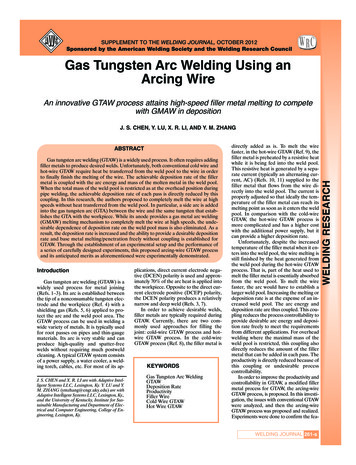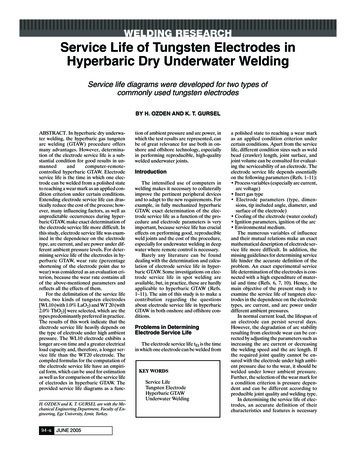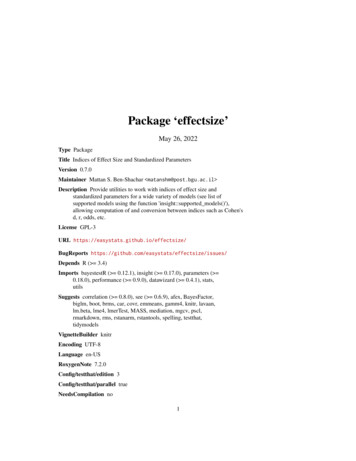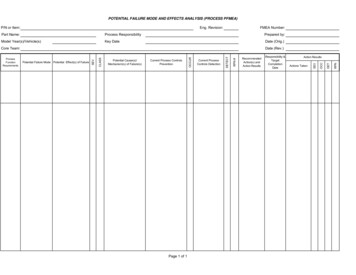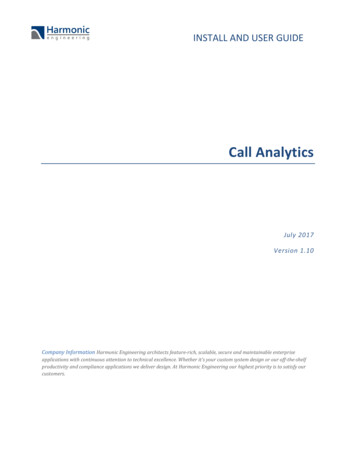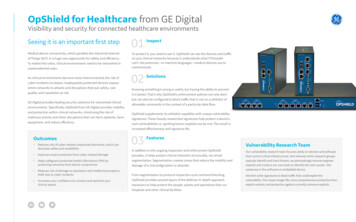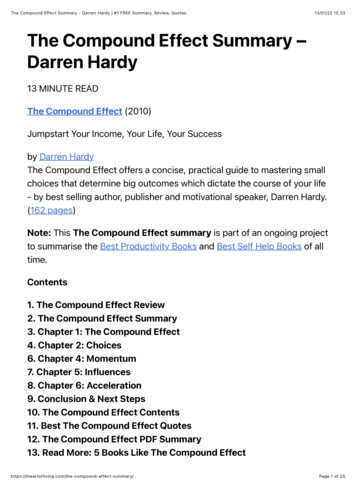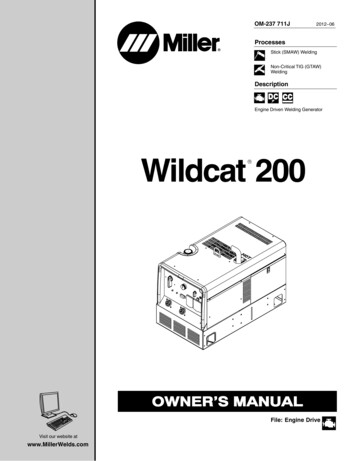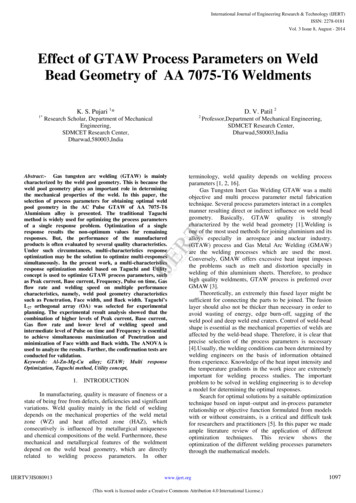
Transcription
International Journal of Engineering Research & Technology (IJERT)ISSN: 2278-0181Vol. 3 Issue 8, August - 2014Effect of GTAW Process Parameters on WeldBead Geometry of AA 7075-T6 WeldmentsD. V. Patil 2K. S. Pujari 1*1*2Research Scholar, Department of MechanicalEngineering,SDMCET Research Center,Dharwad,580003,Indiaterminology, weld quality depends on welding processparameters [1, 2, 16].Gas Tungsten Inert Gas Welding GTAW was a multiobjective and multi process parameter metal fabricationtechnique. Several process parameters interact in a complexmanner resulting direct or indirect influence on weld beadgeometry. Basically, GTAW quality is stronglycharacterized by the weld bead geometry [1].Welding isone of the most used methods for joining aluminium and itsalloys especially in aerospace and nuclear industry.(GTAW) process and Gas Metal Arc Welding (GMAW)are the welding processes which are used the most.Conversely, GMAW offers excessive heat input imposesthe problems such as melt and distortion specially inwelding of thin aluminium sheets. Therefore, to producehigh quality weldments, GTAW process is preferred overGMAW [3].Theoretically, an extremely thin fused layer might besufficient for connecting the parts to be joined. The fusionlayer should also not be thicker than necessary in order toavoid wasting of energy, edge burn-off, sagging of theweld pool and deep weld end craters. Control of weld-beadshape is essential as the mechanical properties of welds areaffected by the weld-bead shape. Therefore, it is clear thatprecise selection of the process parameters is necessary[4].Usually, the welding conditions can been determined bywelding engineers on the basis of information obtainedfrom experience. Knowledge of the heat input intensity andthe temperature gradients in the work piece are extremelyimportant for welding process studies. The importantproblem to be solved in welding engineering is to developa model for determining the optimal responses.Search for optimal solutions by a suitable optimizationtechnique based on input–output and in-process parameterrelationship or objective function formulated from modelswith or without constraints, is a critical and difficult taskfor researchers and practitioners [5]. In this paper we madeample literature review of the application of differentoptimization techniques. This review shows theoptimization of the different welding processes parametersthrough the mathematical models.IJERTAbstract:- Gas tungsten arc welding (GTAW) is mainlycharacterized by the weld pool geometry. This is because theweld pool geometry plays an important role in determiningthe mechanical properties of the weld. In this paper, theselection of process parameters for obtaining optimal weldpool geometry in the AC Pulse GTAW of AA 7075-T6Aluminium alloy is presented. The traditional Taguchimethod is widely used for optimizing the process parametersof a single response problem. Optimization of a singleresponse results the non-optimum values for remainingresponses. But, the performance of the manufacturedproducts is often evaluated by several quality characteristics.Under such circumstances, multi-characteristics responseoptimization may be the solution to optimize multi-responsessimultaneously. In the present work, a multi-characteristicsresponse optimization model based on Taguchi and Utilityconcept is used to optimize GTAW process parameters, suchas Peak current, Base current, Frequency, Pulse on time, Gasflow rate and welding speed on multiple performancecharacteristics, namely, weld pool geometry characteristicssuch as Penetration, Face width, and Back width. Taguchi’sL27 orthogonal array (OA) was selected for experimentalplanning. The experimental result analysis showed that thecombination of higher levels of Peak current, Base current,Gas flow rate and lower level of welding speed andintermediate level of Pulse on time and Frequency is essentialto achieve simultaneous maximization of Penetration andminimization of Face width and Back width. The ANOVA isused to analyze the results. Further, the confirmation tests areconducted for validation.Keywords: Al-Zn-Mg-Cu alloy; GTAW; Multi responseOptimization, Taguchi method, Utility concept,Professor,Department of Mechanical Engineering,SDMCET Research Center,Dharwad,580003,India1.INTRODUCTIONIn manufacturing, quality is measure of fineness or astate of being free from defects, deficiencies and significantvariations. Weld quality mainly in the field of weldingdepends on the mechanical properties of the weld metalzone (WZ) and heat affected zone (HAZ), whichconsecutively is influenced by metallurgical uniquenessand chemical compositions of the weld. Furthermore, thesemechanical and metallurgical features of the weldmentdepend on the weld bead geometry, which are directlyrelated to welding process parameters. In otherIJERTV3IS080913www.ijert.org(This work is licensed under a Creative Commons Attribution 4.0 International License.)1097
International Journal of Engineering Research & Technology (IJERT)ISSN: 2278-0181Vol. 3 Issue 8, August - 2014experimental results coupled with ANOVA results. N.B.Mostafa et.al.[31] described prediction of weld penetrationas influenced by Flux core arc welding (FCAW) processparameters. It deals with the statistical technique to developa mathematical model for predicting weld penetration. K.Elangovan et.al. [32] developed a mathematicalrelationship to predict the tensile strength of friction stirwelded AA2219 aluminum alloy joints.A. Kumar.et.al.[10] was employed Taguchi method tooptimize the pulsed TIG welding process parameters of AA5456 Aluminum alloy welds for increasing the mechanicalproperties. S.C. Juang, and Y.S. Tarng [12] adopted themodified Taguchi method to solve the optimal weld poolgeometry with four smaller the better qualitycharacteristics. Experimental results have shown that thefront height, front width, back height and back width of theweld pool in the TIG welding of stainless steel are greatlyimproved by using this approach.Dr.Taguchi employed DOE, which is one of the mostimportant and efficient tools of total quality management(TQM) for designing high quality systems at reduced cost.This approach helps to reduce the large number ofexperimental trials when the number of process parametersincreases. Most of the works have been published so farfocused on single response performance characteristicoptimization by using Taguchi approach. But the Taguchiapproach is designed for optimizing the single responseproblems. It is not fit for optimizing the multi responseproblems [6].Optimization of a single response results thenon-optimum values for remaining responses. In solvingmany problems in engineering, it is necessary to considerthe application of multi-response optimization, because theperformance of the manufactured products is oftenevaluated by several quality characteristics. Though theTaguchi approach is used for a single response problem,most of the researchers proposed various methods formulti-response problem by modifying it. Some of theresearchers has been efficiently utilized the Taguchimethod andutilityconceptformulti-responseoptimization for various welding, and metal cuttingprocesses such as Laser welding, Sub merged arc welding,face milling, ss casting, electro-chemicalhoning,thermoforming process of polymeric foams, turning ofFree-machining and Gas tungsten arc welding, etc. [5].The main weld bead geometry variables are heataffected zone, bead width, bead height, penetration andarea of penetration. These are greatly influenced bywelding process parameters; welding speed, weldingcurrent, shielding gas flow rate and gap distance. It isnecessary to find an optimal GTAW process conditioncapable of producing desired weld quality. In the presentstudy optimization was performed in such a way that all theobjectives should fulfill simultaneously. Such anoptimization techniqueiscalledmulti-responseoptimization. Senthil Kumar et.al. [8] investigated that theuse of pulsed current parameters has been found to improvethe mechanical properties of the welds compared to thoseof continuous current welds of AA 6061 aluminium alloydue to grain refinement occurring in the fusion zone. ManyIJERTThe investigators [4,19] stated in his paper that theapplication of DOE, evolutionary algorithms andcomputational network are widely used now-a-days todevelop a mathematical relationship between the weldingprocess input parameters and the output variables of theweld joint. Jeng et.al.[19] have used both BPN and learningvector quantization neural networks to predict the .et.al.[20] conducted experiments and carried outconventional regression analysis on some experimentaldata of a TIG welding process, to find its input and outputrelationships.Y.Cho.et.al.[21] studied the effects of various processconditions on weld quality for aluminum using resistancespot welding, mathematical models were established, basedon which the influences of the welding parameters werestudied. G.Casalino[22] investigated the innovative arclaser welding process by means of a regression model anda full factorial experiment and analyzed effect of processparameters. The results showed the significance of someparameters and indicated the way to maximize the weldpenetration. D.Kim.et.al.[23] proposes a method fordetermining the near-optimal settings of welding processparameters using a controlled random search (CRS) wherein the near-optimal settings of the welding processparameters are determined through experiments.U.Esme.et.al. [24] developed nonlinear and multi-objectivemathematical models to determine the process parameterscorresponding to optimum weld pool geometry.KondapalliSiva Prasad.et.al. [13] have made study onfactors effecting weld pool geometry of pulsed currentMicro plasma arc Welding of AISI 304L Austeniticstainless steel sheets using statistical approach. By thedeveloped mathematical models, weld pool geometryparameters can be predicted.D.S.Nageshaet.al.[26] explained an integrated methodwith a new approach using experimental design matrix ofexperimental designs technique on the experimental dataavailable from conventional experimentation, applicationof neural network for predicting the weld bead geometricdescriptors and use of genetic algorithm for optimization ofprocess parameters. Cemal Meran [26]have used stochasticsearch process that is the basis of genetic algorithms(GAs), in developing estimation of the welding parametersfor the joined brass plates. S.C. Juang et.al. [27] have usedneural networks to model TIG welding process for predingweld pool geometry. V. Gunaraj and N.Murugan [28]developed mathematical models for the submerged arcwelding of structural steel plates. The models weredeveloped using the factorial technique to relate developedanempiricalrelationship to predict tensile strength of pulsed GTAWAZ31B magnesium alloy. Incorporating processparameters the developed empirical relationship effectivelyused to predict the tensile strength of pulsed currentGTAW joints.M.Balasubramanian et.al. [30] has been conducted anexperiments to understand the effect of process parametersof pulsed GTAW on titanium alloy weldments andIJERTV3IS080913www.ijert.org(This work is licensed under a Creative Commons Attribution 4.0 International License.)1098
International Journal of Engineering Research & Technology (IJERT)ISSN: 2278-0181Vol. 3 Issue 8, August - 20143. EXPERIMENTAL DETAILS.The schematic diagram of the GTAW welding processis shown in Fig.1 [12]. A non-consumable tungstenelectrode, shielded by inert gas, is used to strike an electricarc with the base metal. The heat generated by the electricarc is used to melt and join the base metal. The travelingspeed of the electrode is controlled by a DC motor, fillerwire pre placed in to the groove of 30 0 and root gap 2mmthe whole experimental set up is shown in the Fig.2. In theexperiments, the welding power source is provided by aGTAW welding machine ―Master TIG MLS 3003ACDC‖. The shielding gas is 99.99% argon and the flowrate of the shielding gas is controlled by a valve meter. Thebase metal is AA 7075-T6 aluminium alloy plates. Asingle-pass welding process is performed because thethickness of AA 7075-T6 aluminium alloy plates is 3.46mm.IJERTconsiderations come into the picture and one need tocarefully balance various pulse current parameters to arriveat an optimum combination.As per the literature review lot of research work wasdone on GTAW of steel alloys and aluminium alloys suchas 5xxx series and 6xxx series. But research work on ACpulse GTAW on high strength aluminium alloys 2xxxseries and 7xxx series is very less. Because of someparticular problems in weldability they include:solidification cracking within the fusion zone, and loss ofalloying elements due to the formation of groove this inturn related to weld bead, loss of strength and poorcorrosion performance. Still lot of research work requiredon these high strength aluminium alloys. And also it wasfound that no work has been reported in the literatureon multi-response optimization of weld pool geometry inGTAW of AA7075-T6 aluminium alloy. Hence, in thisinvestigation an attempt has been made to study theinfluence of AC pulsed current GTAW process parameterson weld pool geometry of AA 7075-T6 aluminium alloyweldment. In the present investigation, a multicharacteristics optimization model based on Taguchimethod and utility concept has been employed to determinethe best combination of the AC Pulsed GTAW processparameters such as Peak current (Ip), Base current (Ib),Welding speed (S), Frequency (F), Pulse on time (Pon),and Gas flow rate (GF) to attain the minimum Face width(B), Back width (C) and maximum Penetration (A). Thepredictive models obtained for performance measures.Confirmation tests are also conducted to verify the results.Heat treatable aluminium alloy AA7075-T6, with 5.106.10% of Zinc as the main alloying element is widely usedfor aerospace applications. Such as transportable bridgegirders, military vehicles, road tankers and railwaytransport systems [7].Fig. 1. Schematic diagram of the TIG welding process2. MATERIALS.The base material used in this study was AA7075-T6 itis in the form rolled sheet of thickness 3.46mm.Thewelding of AA7075-T6 usually involves using a non-heattreatable filler metal such as ER5356 to increase the hotcracking resistance of the weld fusion zone [9]. So in thisstudy selected a commercially available filler wireER5356.The chemical composition of both base metal andfiller wire measured by the method of spectrosparkemission (ASTM-E1251-07) using a Spark AnalyzerSpectromax as given in theTable1.Table1.Composition of Base material, filler wire,aluminium .31ER Bal0.090.08BalFig. 2: Experimental set up for GTAW.From the literature review [9,10] it was found that, themost important process parameters which are havinggreater influence on the weld pool geometry and fusionzone grain refinement of AC pulsed GTAW process are:Peak current (Ip),Base current (Ib), Welding speed(S),Frequency (F),Pulse on time (Pon), and Gas flow rate(GF).A large number of trials have been conducted byvarying one of the process parameters and keeping thewww.ijert.org(This work is licensed under a Creative Commons Attribution 4.0 International License.)1099
International Journal of Engineering Research & Technology (IJERT)ISSN: 2278-0181Vol. 3 Issue 8, August - 2014others constant. The working range of Peak current(Ip),Base current (Ib), Welding speed (S),Frequency(F),Pulse on time (Pon), and Gas flow rate (GF) has beenexplored by inspecting bead appearance, bead contour, andfor any visual defects [11].The working range of theprocess parameters selected under the present study and itslevels are shown in Table 2.Table.2 Process parameters and their IJERTThe GTAW experiments are conducted as per theTaguchi orthogonal array (OA) L27. The rolled plates ofAA7075-T6 aluminium alloy were cut in to the requiredsize (300x150x3.46mm) by using a Jig saw cutting andgrinding. It was investigated by Leijun Li et.al [9] that, thejoint strength of the AL7075-T6 plate when welded withER5356 filler wire with a 0 groove angle gives higherstrength compared to 600 and 900 groove this is because theloss of Zn elements is less in making the groove. In thisstudy we used single butt joint with 300 groove and 2mmroot gap to fabricate AL7075-T6 plate. The plates to bewelded were kept on steel temporary backing plate whichhaving groove of size 7x0.9 mm and ends were clamped tomaintain the alignment and gap. High purity (99.99%)argon gas was used as shielding gas.Initially aluminium plates pickled with NaOH for 10minutes to remove any grease, dust particles following byHNO3 for 15 minutes to remove the oxide layer. The initialjoint configuration was obtained by securing the plate inposition by tack welding. The direction of welding wasnormal to the rolling direction. Single pass weldingprocedure was applied to fabricate the joints.To evaluate the quality of TIG welds, themeasurements of the weld bead geometry are performed asshown in Fig.3. In this study, the Penetration (A), Facewidth (B), and Back width (C) of the weld bead are used todescribe the weld pool geometry. The weld beadgeometries were measured using Up-right reflected andtransmitted metallurgical microscopy system; Make: VTVacuum Technologies Pvt. Ltd; Model No. EQMSXJM213H-3M. Typical weld bead geometry is shownin Fig.3 and measured by a Metallurgical Microscope.Sample preparation and mounting was done as per ASTME 3-11standard [13]. Two samples at a distance of 15 mmto each other are cut at the middle of the welded joint [14].Samples being located at 15 mm behind the trailing edge ofthe crater at the end of the weld to eliminate the end effects(Fig.4). The samples are mounted using cold setting binderand cold setting compound as shown in Fig 5. The etchingreagent Keller‘s was made by using chemicals 2 mlHF,3ml HCl, 20ml HNO3and 175ml H2O with an etchingtime of 30 sec. Weld pool geometry parameters wereobserved and recorded using a metallurgical microscope.The recorded specimen weld pool geometry qualitycharacteristics namely Penetration (A), Face width (B), andBack width (C) are as shown in the Table 3.4.2 The Utility concept.A client evaluates a product on a number of diversequality characteristics. To be able to make a rationalchoice, these evaluations on different characteristicsshould be combined to give a combined index. Such acombined index represents the utility of a product. Theoverall utility of a product measures the usefulness of thatproduct in the view of the client. The utility of a product ona particular characteristic measures the usefulness of thatparticular characteristic of the product. The overall utilityof a product is the sum of utilities of each of the g(This work is licensed under a Creative Commons Attribution 4.0 International License.)1100
International Journal of Engineering Research & Technology (IJERT)ISSN: 2278-0181Vol. 3 Issue 8, August - 2014Table.3 Experimental layout using an L27 orthogonal array and Experimental results for the weld pool 5205205205205GTAW Process 191010119101199101111910119101011991011Weld pool geometry .3IJERTExpt.NoThus if xi is the measure of effectiveness of theattribute i and there are n attributes evaluating the outcomespace, then the joint utility function can be expressed as: .(1)In linear case, the function becomes: . (2)where, Wi, is the weightage assigned to the attribute i andthe sum of the weightage for all attributes is equal to 1. Ifthe overall utility is maximized the quality characteristicsconsidered for evaluation of utility will automatically beoptimized maximized or minimized whatsoever the casemay be.Fig. 4. Marking for cutting specimenIn this study for optimizing the process parameters,three quality characteristics were considered as a singlecharacteristic by using above mentioned utility concept.Figure 3: Weld pool geometry; Penetration (A),Face width (B), Back width (C)Fig. 5. Specimens for measuring weld pool geometryThe utility value (Single characteristics response) ofeach GTAW specimen has been calculated using thefollowing relation:U(n,R) PA(n,R)xWA PB(n,R)xWB PC(n,R)xWC .(3)Where, n trial numberIJERTV3IS080913www.ijert.org(This work is licensed under a Creative Commons Attribution 4.0 International License.)1101
International Journal of Engineering Research & Technology (IJERT)ISSN: 2278-0181Vol. 3 Issue 8, August - 2014n 1,2, . . ., 27R repetition, R 1, 2,WA, WB, WC are the weightage for weld pool geometryPenetration (A), Face width (B),Back width (C)respectively. From the previous literature survey it hasbeen found that the quality characteristics Penetration (A),Face width (B), and Back width (C) are not equallyimportant [12] and hence unequal weightage has beenassigned but summation of all weightage must be equal to1[12]. The weights assigned are:WA 0.50, WB 0.35, WC 0.15PA, PB , PC are the preference scale for weld pool geometryPenetration (A), Face width (B),Back width (C)respectively. These values calculated as given below;If a log scale is chosen the preference ( ) is given byEquation . (4)Where any value of quality characteristic or attribute i minimum acceptable value of quality characteristic orattribute i K a constantAt optimum value ( ) of attribute i, Pi 9 So, K atoptimal value ofis given by . (5)4.3.1 Single response optimization and its confirmation.Effect on penetration (A)The penetration (A) was considered as the qualitycharacteristic with the concept of "the larger-the-better".The analysis was made using the popular softwarespecifically used for design of experiment applicationsknown as MINITAB 15. The average values of penetration(A) for each parameter at levels 1, 2 and 3 for raw data areplotted in Fig.6 From the this Fig. it clears that peakcurrent (Ip), frequency (F), and pulse on time (Pon) are themost significant process parameters compared to otherprocess parameters.Fig.6 shows that as the increase in Peak current (Ip)up to 200A the penetration (A) value decreases andpenetration (A) value increases with further increase in Ipvalue. This is because at low Ip up to 200 Amp the heatinput is less and it is not sufficient to melt base metal withthe filler material. The Peak current (Ip) more than 200Agives more heat and it melts the base metal with filler metalcompletely and gives full penetration (A). So Peak current(Ip) plays an important role in the determination ofpenetration (A) value. As the base current (Ib) increases theup to 98 A the penetration (A) value go on increasing andafter 98 A further increase in Ib value there is decrease inpenetration (A) value. As the base current (Ib) increaseshigher the value of penetration (A). This is because the Ibis mainly helpful in maintaining continuous arc duringwelding [13], so it melts more base metal and fillermaterial in narrow direction so penetration (A) increases.Though from Fig.7 Ib process parameter not as significantas other parameters. As the welding speed (S) decreasesthe penetration (A) value go on increasing this is mainlybecause, lesser the speed complete melting of submergedfiller material and base metal leads to complete diffusion offiller metal in to base metal and forms a perfect joint. Asthe Frequency (F) increases penetration (A) go onincreasing proper diffusion of filler metal in to the basemetal so the penetration (A) value increases. But furtherincrease in the F from 6Hz more penetration than requiredleads to undercut and decrease in penetration (A) value.IJERTPreference scale calculation for A Maximum acceptable value considering the 27experiments 4.5 mm (assumed) Minimum acceptable value considering the 27experiments 2 mm (assumed)(All the A values in Table 3 are in between 1.5 to 5)Using these values and the Equations 4 & 5, the followingpreference scale for A has been constructed; . (6)Preference scale calculation for B Minimum acceptable value considering the 27experiments 6.0 mm (assumed) Maximum acceptable value considering the 27experiments 8.0 mm (assumed)(All the B values in Table.3 are in between 6 to 9.0)Using these values and the Equations 4 & 5, the followingpreference scale for B has been constructed; . (7)Preference scale calculation for C Minimum acceptable value considering the 27experiments 0.1 mm (assumed) Maximum acceptable value considering the 27experiments 6.0 mm (assumed)(All the C values in Table.3 are in between 0.1 to 6.5)Using these values and the Equations 4 & 5, the followingpreference scale for C has been constructed; . (8)The utility values with mean are calculated and given inTable 4.4.3 Results and discussion.IJERTV3IS080913www.ijert.org(This work is licensed under a Creative Commons Attribution 4.0 International License.)1102
International Journal of Engineering Research & Technology (IJERT)ISSN: 2278-0181Vol. 3 Issue 8, August - 2014Table. 4 Utility Data Based on Quality Characteristics A,Band C with its 19.20.21.22.23.24.25.26.27.Utility 1Utility 28.456785.438743.939893.82305Interaction Plot for Means(WP-A)Data Means93Main Effects Plot for 05200300400Fig. 7 Effects of Interactions on WP-A (Raw Data)S4.0Mean of 00GF400468405060910114.54.03.53.0Fig.6 Effects of Process Parameters on WP-A (Raw Data)Though from Fig.6 Ib process parameter not assignificant as other parameters. As the welding speed (S)decreases the penetration (A) value go on increasing this ismainly because, lesser the speed complete melting ofsubmerged filler material and base metal leads to completediffusion of filler metal in to base metal and forms a perfectjoint. As the Frequency (F) increases penetration (A) go onincreasing proper diffusion of filler metal in to the basemetal so the penetration (A) value increases. But furtherincrease in the F from 6Hz more penetration than requiredleads to undercut and decrease in penetration (A) value.From the Table 4 it was found that Gas flow rate (GF),Base current (Ib) and welding speed (S) are lesserIJERTV3IS0809131034Data MeansIp985The optimal GTAW process parameters for maximumpenetration (A) are Ip-205A , Ib-103A, S-200mm/min, F6Hz, Pon 60%, and GF-10 lit/min. Fig. 7 reveal that theinteractions between Peak current (Ip), Base current (Ib),Welding speed (S) affect highly the output responses sincethe responses are not parallel to each other. So oursuspected interactions are significant on responses.Effect on Face width (B)The face width (B) was considered as the qualitycharacteristic with the concept of "the smaller-the-better".The average values of face width (B) for each parameter atlevels 1, 2 and 3 for raw data are plotted in Fig.8. From thisFig it clears that Peak current (Ip), welding speed (S), pulseon time (Pon) and gas flow rate (GF) are the mostsignificant process parameters compared to other processparameters. Fig.8. shows that as the increase in Peakcurrent (Ip) up to 200A the face width (B) value decreasesand face width (B) value increases with further increase inIp value. This is because at low Ip up to 200 Amp the heatinput is less and it is not sufficient to melt base metal withthe filler material. The Peak current (Ip) more than 200Agives more heat and it melts the base metal with filler metalcompletely and increases face width (B). So Peak current(Ip) play an important role in the determination of facewidth (B) value. As the base current (Ib) increases the up to98 A the face width (B) value go on increasing and after 98A further increase in Ib value there is decrease in facewidth (B) value. As the base current (Ib) increases higherthe value of face width (B). This is because the Ib is mainlyhelpful in maintaining continuous arc during welding [13],so it melts more base metal and filler material in narrowdirection so face width (B) increases. On the other handfrom Fig. 8 Ib process parameter not as significant as otherparameters.IJERTExpt.nopercentage of co
computational network are widely used now-a-days to develop a mathematical relationship between the welding process input parameters and the output variables of the . thermoforming process of polymeric foams, turning of Free-machining and Gas tungsten arc welding, etc. [5]. The main weld bead geometry variables are heat affected zone, bead .
